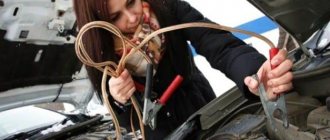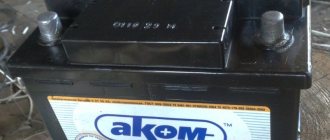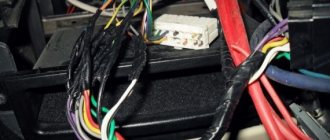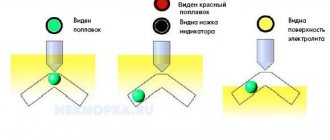Often an attempt to start a car in the morning turns into failure: the starter suddenly barely turns the crankshaft, and the dashboard lights blink in time with the jerks. In the most extreme case, the car simply shows no signs of life. These things happen after a few days of being parked, and the first recommendation in such cases (if nothing was left on) would be to check for electrical leakage in the car.
This term originated in the days of carbureted cars, in which, after turning off the ignition, there was not a single consumer connected to the battery, and any current consumption without turning the ignition on was considered a leak. Nowadays, everything is more complicated: even on budget cars, electronic units are constantly included in the on-board network, which, although they can “sleep” to save energy, still consume current constantly. In this case, it is more difficult to check and distinguish the leak from normal vehicle behavior.
Diode bridge reverse current
At one time, this was the main reason for excessive battery discharge - the generator remained the only device directly connected to the battery after the ignition was turned off. A car generator is a three-phase (rarely four-phase) alternating current machine, which must be straightened for use in the on-board network. The diode bridge is responsible for this - a characteristic “horseshoe” of powerful semiconductor diodes, which is connected in the car circuit between the stator windings and the battery.
An ideal semiconductor diode conducts current in one direction, which is the basis for their use in AC rectifiers. But in practice, the diode also has a reverse current - when connected to the battery, the diode bridge slowly drains the battery onto the stator windings. Normally, the reverse current of the diode is several milliamps; taking into account the fact that there are several of them in the bridge, the normal reverse current of the assembly is considered to be 20-40 mA.
However, semiconductors degrade over time, which leads to a change in the parameters of the diode, including an increase in the reverse current. So leaks can increase significantly - and the constant load can be a hundred or two milliamps.
Causes and consequences
First you need to understand what a car battery is. Like any other battery, it is a chemical current source that has an electrical capacity, the value of which is usually printed on the battery label. It is measured in ampere hours (Ah).
Battery capacity is measured in ampere-hours and shows how much current the car battery will be discharged with.
In fact, capacity determines the amount of electrical energy that a fully charged battery can deliver. Leakage current represents the current drawn from the battery. Let's say we have a serious short circuit in the car wiring, and the leakage current is 1 A. Then the 77 Ah battery given as an example will be discharged in 77 hours. During use, the battery life and its effective capacity decrease, so the starter may not have enough starting current even when the battery is half discharged (in cold weather up to 75%). With such a leak, it can be assumed that in a day it will become almost impossible to start the car with the key.
The main problem is that the battery is deeply discharged. When receiving energy from the battery, the sulfuric acid included in the electrolyte is gradually converted into lead salts. Up to a certain point, this process is reversible, since a similar thing happens when the battery is charged. But if the voltage in the cells drops below a certain level, the electrolyte forms insoluble compounds that settle on the plates in the form of crystals. These crystals will never recover, but will reduce the working surface of the plates, leading to an increase in the internal resistance of the battery, and, therefore, a decrease in its capacity. In the end, you will have to buy a new battery. A dangerous discharge is considered to be a voltage below 10.5 V at the battery terminals. If you bring your car battery home to charge and notice lower voltage, it's time to sound the alarm and deal with the leak immediately!
In addition, leaks caused by short circuits or melted wiring insulation at sufficiently high currents can lead not only to battery damage, but also to fire. Indeed, a new car battery is capable of delivering hundreds of amperes over a short period of time, which, according to the laws of physics, can lead to melting and ignition in a few minutes. Old batteries can boil or explode under constant increased load. Even worse, all this can happen completely by accident at any time, for example, at night in a parking lot.
The electrical system of a car is a complex of complex electronic systems interconnected
After considering all the unpleasant consequences of leakage current, it is worth understanding its causes. Previously, in the days of carburetor cars with a minimum of electronics, the normal leakage current was considered to be its complete absence. In those cars there was simply nothing to draw current from the battery when the ignition was turned off. Today everything has changed: any car is simply crammed with various electronics. These can be either standard devices or installed later by the driver. And although all modern electronics, accompanied by a friendly march of environmentalists with slogans about energy saving, support special “sleep” or standby modes with very low energy consumption, a certain amount of current is consumed by duty circuits. Therefore, small leakage current values (up to 70 mA) are the norm.
From the factory equipment in a car, the following devices normally constantly consume a certain amount of energy:
- Diodes in the generator rectifier (20-45 mA);
- Radio tape recorder (up to 5 mA);
- Alarm (10-50 mA);
- Various switching devices based on relays or semiconductors, on-board engine computer (up to 10 mA).
The maximum permissible current values for serviceable equipment are indicated in parentheses. Faulty components can dramatically increase their consumption. We will talk about identifying and eliminating such components in the last part, but for now here is a list of additional devices installed by drivers, which can often add another hundred milliamps to the leak:
- Non-standard radio;
- Additional amplifiers and active subwoofers;
- Anti-theft or second alarm;
- DVR or radar detector;
- GPS navigator;
- Any USB powered equipment connected to the cigarette lighter.
Article on the topic: What is the difference between an 8 valve engine and a 16 valve engine?
Incorrect connection of the radio
A classic mistake - and a classic way to drain your battery. The fact is that modern radios are designed to be used only with the ignition switch set to the “accessories” (ACC) position or with the ignition on, for which a separate signal wire is used, connected to the ignition switch. Plus, the radio's power goes directly to the battery.
Without a key, such a radio cannot be turned on, which sometimes prompts people to tightly connect the ACC wire from the radio to the ignition positive so that it always turns on. But the problem is that with a standard connection, as long as the key is removed from the lock, a minimum of circuits remain energized in the radio. This low-power "sleep" mode is initiated by turning off the voltage at the ACC pin.
If the radio is turned off with a button on the panel, and the voltage at the ACC pin remains, then instead of the “sleep” mode, most models go into standby mode, when power consumption is much higher. Thus, an incorrectly connected radio can add 40-50 mA to the total leakage current.
We also include amplifiers here - they are directly powered by batteries, and to save energy, a signal wire controlled by a radio is used. You yourself understand how much a powerful amplifier can “suck” if you accidentally tear off this wire while taking something out of the trunk and leaving the amplifier on.
Main causes of current leakage
Location of the battery on a Lifan Smiley car
Location of the battery on a Lifan Breeze car
Location of the battery on a Lifan Solano car
As practice shows, a popular reason for battery discharge is the owner’s inattention to his vehicle. Before looking for faults in the car's electrical wiring, you need to look under the hood. It may be that the battery has exhausted its service life (short-circuiting the battery) and it is time to replace it with a new one. The presence of traces of oxidation on the terminals or current-carrying wires in poor condition - all this can cause discharge leakage.
The second main reason is driver forgetfulness.
Sometimes he may forget to turn off the headlights or side lights, or the light bulb in the car. If the above reasons existed, then you should not go further and look for problems in the electrical wiring.
What current leakage is permissible in a Lifan car?
When parked, the battery ensures the normal operation of some systems when the engine is turned off. Equipment that must receive constant power includes:
- car alarm;
- electronic engine control unit;
- electric clock in the cabin;
- car radio memory.
Therefore, modern batteries for Lifan cars and other models are designed for a certain leakage current. For example, a clock consumes approximately 1 mA, a car alarm consumes 20 mA. The total leakage current that a working battery can withstand does not exceed 50-80 mA. With such a leak, the battery in the car can be discharged for months. But if you leave one light bulb on, the current consumption increases tenfold. The lighting in the Lifan interior consumes approximately 500-600 mA of current.
You can measure the leakage current yourself. If the value exceeds the permissible value, then you should look for the cause of the leak and eliminate it as quickly as possible.
Problems with alarms and security systems
Alarms and immobilizers must work while the car is parked with the engine turned off. This also contributes to leakage currents and, although when developing such systems they strive to reduce energy consumption to a minimum, they always need some current.
In modern security systems, controllers can “go to sleep,” but in the event of software failures or malfunctions, such alarms will continue to consume increased current. Cheap models also have more serious problems - for example, a car equipped with a simple Chinese two-way alarm system tightly blocked the operation of the automatic box doors and standard alarm systems of neighboring cars, clogging the radio range with the constantly working transmitter of the antenna unit. The battery of this car was regularly noticeably discharged in the morning.
Current leakage from the battery when the ignition is turned off
THIS ARTICLE IS MORE FOR MYSELF, I WANT TO CHECK MY OPEL ASTRA GTC AT MY LEISURE.
If the car is parked for a very long time and is not used, then after the driver turns the key in the ignition, nothing will happen. In the process, the relay may click, perhaps even the starter will come to life. But even if it rotates the crankshaft, it is not enough. All of these are symptoms of the battery being discharged while the car was parked. There is a standard for current leakage in a car. But when the battery is discharged, these indicators are significantly higher than these normal values. Let's look at how you can detect current leakage and fix this fault.
WHY DOES THE BATTERY GO DOWN? During long-term parking, the charge should not go away, but leakage currents must also be taken into account. The battery discharges especially quickly in modern cars. Here, a considerable number of different electronic devices and gadgets are included in the network.
Often in such cases, the rate of current leakage in the car is much higher than permissible. Typical causes include old and poor-quality wiring, as well as wire insulation. Another common cause is improperly connected electronic equipment. This could be an audio system, multimedia, navigator, and so on. The causes of current leakage in a car may be dirty or oxidized contacts. All this significantly drains the battery.
ALLOWABLE STANDARDS FOR CURRENT CONSUMPTION OF THE BATTERY. Modern machines have a certain number of consumers of electrical energy on an ongoing basis. This could be a clock, ECU memory, immobilizers, alarms and other similar equipment. They are connected to the network and consume electricity. And all the time. For example, let's take the volatile memory of an ECU. If you erase it, the unit will begin the relearning process and will again remember all current settings. Security systems only start working when the car is parked. From this we can conclude that low electrical energy consumption is a normal situation. But there is a norm for current leakage in a car. This norm is a certain constant value - it can be calculated. It is necessary to sum up the consumption of each consumer in the on-board network. For example, alarms require no more than 20 mA. The clock requires 1 mA to operate. The audio system consumes about 3 mA and so on. In total, the total figure will be in the range from 10 to 80 mA (0.01-0.08A). It's quite a bit. Even one lamp in the headlight, which they forgot to turn off, consumes 500 mA. And the current leakage rate in a car of 50 mA (0.05A) cannot cause a complete discharge of the battery even in winter. You can determine how much consumption there is using a multimeter. And if during the measurement process the consumption level is higher than permissible, that means. There is a problem in the on-board network. It needs to be found and eliminated.
WE DETERMINE WHERE THE CURRENT GOES INDEPENDENTLY. As you know, there are only two main reasons why batteries are severely discharged. These are additional consumers or a short circuit in the network. So, let's see how to measure current leakage in a car with a multimeter.
Malfunctions of switching equipment
Loads connected to live wiring through switches or relays may cause increased leakage current. In any case, the source of problems is the contacts, no matter the switch or relay - burnt and deformed from overload, they may not open completely, maintaining, albeit large, resistance through which current will flow.
However, such cases are rare. But in modern cars with complex control systems for on-board consumers, the circuits are switched by semiconductors, and not by classic relays. And any semiconductor also has a reverse current - in switching transistors it is negligible, but in the event of a malfunction it increases to noticeable values, not to mention cases of breakdown of the transistor when the load is no longer disconnected from the power supply.
Video: Finding a current leak in a car
Troubleshooting
It’s easy to check the leakage current on a car battery yourself with a multimeter. To do this, it is not at all necessary to contact a service center, a trip to which will require both time and money. To check the on-board network on your own, you will only need a 10-mm wrench and a multimeter capable of measuring currents of at least 3-5 A. If not all, then most avometers (testers), including Chinese ones, have this measurement limit.
These instruments can measure DC current up to 10 A (left) and 3 A (right).
Total current measurement
Checking current leakage in a car with a multimeter is done by measuring the current consumed from the battery by the car's equipment when the ignition is turned off. To do this, it is necessary to carry out all the manipulations that are performed when parking the car: turn off consumers (headlights, heaters, air conditioners, etc.), turn off the ignition, activate the security system, if any, and close all doors tightly. Before this, of course, you need to open the engine compartment lid where the battery is installed. Additionally, it is worth lowering the glass in one of the doors in case manipulations with the battery cause accidental activation of the door locks.
Causes of battery current leakage
The battery is considered one of the main components of a car's operation. It must be charged, thereby ensuring the operation of the engine and other devices. Often the cause of current leakage is the owner's forgetfulness. Many people leave their car overnight with the equipment turned on or put off buying a new battery for a long time. In addition, current may leak due to irregularities in the wiring. Thus, the causes of leakage are:
- Long battery life;
- Headlights, lights, radio not turned off;
- Destruction of the insulating layer of wires under the influence of unfavorable climatic and road factors;
- Oxidation of main components or accumulation of a layer of dirt on them (sockets for connecting devices, contacts of terminal blocks);
- Short circuit in the wiring of additionally installed equipment due to carelessness in laying the wires;
- Damage to wires by metal fasteners;
- Melting of some sections of wiring located near the engine.
Having ruled out the possibility that the driver does not forget to turn off the headlights and electronics, you should look for a current leak in another place.
Main causes of the problem
The first source of suspicion to come under suspicion is the power source of an unstarted car - the battery. The main reason for the discharge of a passenger car battery is the inability to accumulate energy while the car is moving using a generator. Therefore, the first action is to measure the voltage at the terminals with the ignition off.
Battery failure can occur due to the inattention of the motorist. External and internal lighting and electronic devices (radio tape recorder, recorder) are often left on; the anti-theft system may not work correctly.
But the main reasons for current leakage, according to experts, are violations of the integrity and wear of electrical wiring, incorrect installation of non-standard electrical appliances. Such problems in the electrical network can lead to a short circuit and fire in the car. If checking the battery shows its normal operation, it is necessary to diagnose for current leakage.
Diagnostics and standard battery leakage current
There are devices in the car that consume current regularly. These include:
Their functioning requires constant nutrition. After a reboot, the volatile memory starts working again, remembering the current installation functions. The vehicle is protected from the moment it is parked. All of these devices require current, which means it is possible to consume a small amount of energy on a regular basis.
Since current is used to operate many volatile devices, it should be indicated that there is a leakage rate. It is a constant value, which is calculated by summing the consumption volume of each device. If the constant consumers in a car are the clock, alarm system, and audio system, then the sum of their current consumption will be 1mA+20mA+3mA, respectively. When adding the current values for all devices operating constantly, a total sum is obtained in the range of 50–80 mA.
When compared to a headlight bulb, which consumes about 500 mA, a current leakage rate of 50 mA cannot affect battery discharge.
To determine the rate of current leakage in your own car, you should carry out diagnostics. This is done by measuring current consumption. When a consumption value is detected that is greater than normal, it becomes necessary to troubleshoot electrical equipment or the on-board network.
How to measure leakage current
Before you check for current leakage in a car, you need to prepare - for a safe and high-quality diagnosis, you should have the following tools and items on hand:
- ammeter and voltmeter;
- flat screwdriver and wrench;
- paper and pencil;
- cotton gloves;
- shunt and clamps.
It is advisable to carry out the diagnosis together, take all precautions and be careful. Carry out the following mandatory work:
- de-energize all installed non-standard (radio tape recorders, acoustics, radars and recorders) and standard (lamps, cigarette lighter) devices that consume electricity;
- do not insert the key into the ignition, turn off the car;
- provide access to the engine compartment of the car and securely fix the hood cover;
- disconnect the battery.
Self-diagnosis with a multimeter
Diagnostics is carried out using a conventional multimeter (tester). Current measurements are carried out in a mass discontinuity or in a “positive” section discontinuity. The mass discontinuity detection scheme is considered safe. To do this you need to do the following:
- The multimeter settings correspond to measuring current readings in amperes (10-20 A);
- Disconnect the negative terminal from the battery;
- Connect one wire of the tester to the battery terminal;
- The other wire of the tester should be on the removed wire.
The polarity may not be observed for the electronic tester. Before starting measurements, turn off the ignition and remove the key.
Detecting a leak in the positive gap involves the following scheme:
- Set the amperes on the device;
- Disconnect “+” from the battery;
- Connect the negative connector of the tester to the disconnected battery terminal;
- Connect the positive connector of the tester to the “-” battery.
If the steps are completed correctly, a current value will appear on the tester screen. Exceeding the norm (15–80 mA) by the found current value indicates a leak. As a result, you need to look for the problematic circuit.
How to check?
Despite the fact that this procedure initially seems very complicated, it is quite simple to perform it yourself. To do this, on the car you need to turn on the multimeter in ammeter mode directly into the gap between the battery and the rest of the network. The car engine must be turned off. Also, no manipulations with the ignition should be carried out. After this, the procedure should look like this:
- Turn off the ignition and additional current consumers;
- Unscrew the negative terminal from the battery;
- Set the multimeter to DC ammeter mode;
- Set the maximum measurement limit (10-20 A);
- Connect the probes to the marked sockets;
- Connect the probes into the gap: black to minus, red to ground;
- Look at the device readings.
As for the normal value of leakage currents, they may differ for different cars. Roughly, the norm is considered to be 20-70 mA. For older cars, this value may be higher. And modern cars can even display results in units of mA on the device.
Learn more about how to check current leakage in this video:
Published: December 03, 2020
How to find a leak
Leakage may be caused by an unauthorized consumer or a short circuit in the circuit. The search begins with non-standard devices and electronic components. Unlike factory wiring, newly installed equipment can be powered by wires laid in the first available location. If you want to quickly place everything, the master does not pay attention to the fact that the wiring may lie near the motor. During operation, the unit generates heat that acts on the insulating layer of the wires. As a result, melted areas appear.
When cables are located near metal places that are constantly in contact, chafing can occur. The integrity of the wiring is compromised, leading to a short circuit.
Therefore, after preliminary diagnostics using a multimeter, it is worth visually inspecting individual areas and elements of equipment placed after purchasing the machine. Often, alarm limit switches are placed where the doors touch. Look for burned, corroded or damaged areas. If these are not found, then it is worth moving on to the stage of in-depth diagnostics.
Leakage current. Causes and dead battery
First you should inspect the battery and wiring. This must be done because the reasons may be old and poor-quality wiring, poor wire insulation, incorrectly connected electronic equipment (audio system, multimedia, navigator, etc.), dirty or oxidized contacts. Before checking the leakage current with a multimeter, check all the listed reasons, they all significantly drain the battery. Most often, it is for these reasons that the battery runs out, less often because of failed electronic units or on-board network components.
After visual diagnostics, you should definitely check the charge of the car battery. The car's alternator may work intermittently and provide charging inconsistently. How to check charging using a multimeter and also without it, I described in this article
How to perform in-depth diagnostics
In-depth diagnostics are carried out after a visual inspection of the wiring. The point of the method is to turn off any equipment and measure the current using a multimeter. Scheme of operations:
- Install equipment to measure current in amperes by removing the negative terminal of the battery;
- Connect the tester wires to the disconnected battery wire and to the negative terminal;
- Pull out the fuses one by one, opening the circuit;
- When the current changes, find out which equipment this fuse is responsible for.
Another way to measure is to make a homemade adapter. A blown fuse is used for this. The multimeter probes are connected to the adapter made. The process is similar - checking different circuits separately.
After identifying the suspicious location, a short circuit is detected by testing the wires using a tester. You must first set the resistance measurement mode.
There are exceptions to testing this way, since not all equipment works together with fuses.
Repairing the leak
When a leak is identified, it is necessary to begin eliminating the cause. Before performing any operations, the battery terminals must be removed. Solutions:
- Accumulation of dirt at the connection areas - dust and dirt should be removed using an alcohol solution.
- The insulation is damaged - close the internal conductors and provide protection from further exposure to negative factors (put on a hose to prevent overheating and chafing);
- Water or fogging in devices - dry. If water gets inside the alarm unit, you need to carefully open the module. After moistening with alcohol, wait for the water and dirt to drain. After removing fogging, come up with a protective cover that prevents moisture from penetrating inside.
- Malfunctioning electronic device - repair or replacement.
Having eliminated the cause of the leak, you should again check the current consumption rate with a multimeter.
In the video you can learn more about constant current consumers and checking current leaks. Two machines are compared that have different current consumption depending on the installed equipment.
Normal limits
The permissible current leakage in a car is 15 mA - 50 mA - 70 mA, taking into account the number of electrical appliances installed in the car. If the device readings are within the normal range, then everything is fine, but if they significantly exceed the norm, then you need to look for the problematic circuit in which the leak occurs. So, you can find a current leak in a car in this way: turn on the ammeter and place it in such a way that you can clearly see it. Then one person takes readings while looking at the ammeter, and the second takes out fuses in a row while standing at the fuse box.
Carefully! You need to turn off the ignition, close the doors, and open the windows: suddenly the central locking will work when you disconnect/connect the battery. If you remove one of the fuses and the ammeter shows normal at this time, you have found the problem circuit. It is in it that the device that absorbs the current is located.
Generator check
If you cannot find the cause of the leak after removing the fuses, you are left with the option of diagnosing the operation of the generator. It is often the source of the problem because it is not supplying charge to the battery. Generator testing steps:
- The tester probes are connected to the battery terminals (plus to plus, minus to minus);
- The device is set to voltage measurement mode;
- During the measurement, readings of 12.6–12.9 V should appear, indicating that the battery is charging;
- Start the car;
- Turn on low beam, heating, heated rear window;
- Measure the voltage using a multimeter.
The measurement value of 12.8–14.3 V corresponds to the operability of the generator. Readings less than 12.8 V indicate that the generator is not charging the battery.
Diagnosing vehicle problems often involves analyzing the condition of the battery. A dead battery will cause the car to not start. Detecting current leaks will help avoid such situations. Moreover, everyone can correctly determine current leakage.











